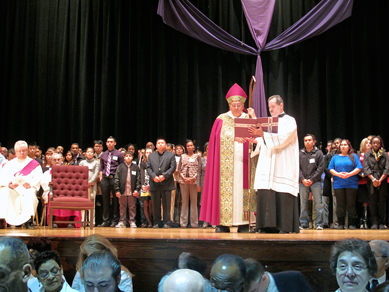My dear brothers and sisters in the Lord,

One of the most rewarding ceremonies of the liturgical year is the Rite of Election, when we welcome the catechumens, candidates for full communion and the candidates completing their initiation into the Church. On Feb. 26, I presided at the Rite of Election held at Christ the King Regional H.S., Middle Village. Annually, there are two ceremonies, given the great number of attendees for this joyful occasion. A total of 949 catechumens and candidates were present this year. Of the 949, there were 409 catechumens entering the Church through the Sacraments of Initiation: Baptism, Confirmation, and Eucharist. The ceremony also recognized 49 candidates who will enter into full communion with the Church by a profession of faith. An additional 491 candidates, who will complete their initiation into the Catholic Church at the Easter Vigil, were also present.
A special characteristic of this day is that we truly see the reflection of the multi-ethnic character of the Diocese of Brooklyn. As each name is read, the readers are challenged to pronounce, as best they can, names that may seem difficult for some to pronounce. You can see that there is a palpable sense of joy as we celebrate this rite at the very beginning of every Lent.
The new Rite of Christian Initiation for Adults (RCIA), developed after the end of the Second Vatican Council, began the new way in which the Church invites new members and fully initiates those already baptized into full communion with the Church. The ceremonies that begin with the Rite of Election and carry through Lent are the liturgical aspects of welcome, most of which happen at the local parish where people are catechized. The second aspect is the catechesis that is vitally important because, besides welcoming the people into the Church, they should know to what we are welcoming them.
I recall as a young priest in the first years of the 1970s having “convert class” individually with each convert. It was sometimes a long and laborious process in the parish office working with a book and talks to help the converter better understand the doctrines of the Church. I remember the excitement of the first years after the Rite of Christian Initiation (RCIA) was issued, and we started to use it in the parish in which I was assigned. It was amazing, and at the same time the catechesis changed from individual sessions to group sessions where all priests of the parish began to participate, as well as religious and lay people. It was a better way of catechizing those who wished to enter the Church and those who had finished their sacramental initiation. What a truly renewing experience in the life of the parish in which I first served. We have come a long way in almost 40 years in perfecting the welcome of the Church and the catechetical instructions which should be Scripturally-based and following the liturgical year.
The content of the faith is critical. Several studies have been done regarding the retention rate of new converts. Many who are received with such joy at Easter, unfortunately, several years later fall away and no longer practice their faith. I always mention this in my sermon at the Rite of Election, that the retention of the practice of the faith is as important as the process of accepting the faith. We should do some research in our own diocese here in Brooklyn and Queens to find out the retention rates in the parishes.
One issue seems to be clear. Candidates seem to receive special attention from the parishioners. But after they are received, they become like everyone else in our parishes and they retain a certain amount of anonymity. There are those who become very involved in the parish, but there are many others who find no way to practice their newly acquired faith.
I believe that the liturgical practice of the Mystogia or the post-baptismal catechesis is as important to the RCIA as the initial catechesis. There is a celebration of the Mystogia at a Mass, 40 days after Easter. Unfortunately, only about 10% of those at the Rite of Election attend. This is a fact also that I bring out in my Rite of Election sermon. It is important that we accompany our new converts and newly fully-initiated members of our faith with our attention long after the initial liturgical and catechetical work is completed.
Although the new RCIA can always be improved, it is perhaps the best thing about the welcome of the Church today. The New Evangelization, while always inviting back those who have lost the practice of the faith, continually seeks those who do not know Christ and to welcome them to the faith. It is an exercise in putting out into the deep, as we try in the midst of an overcomplicated and busy world, to call individuals to faith in Jesus Christ through the sacraments of Baptism, Eucharist and Confirmation.
Join me in praying for our catechumens and candidates welcomed in the new Rite of Election.
